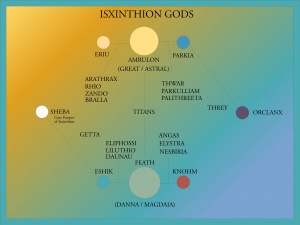Isxinthion Gods
The Isxinthion [anglicized pronunciation: /ɪskˈsinθɪən/] Gods are the acknowledged beings of divine power in the West. According to the oldest traditions, oral and subsequently recorded in ancient texts, these divinities once ruled the world of Asdar in person some fifteen thousand years ago. Their relationship to the titans is unknown, but it is thought that both humans and titans dwelt on the world side-by-side, with the titans wielding technology far superior than today's titancraft. Some scholars believe the Isxinthion Gods were unique to the west, but others believe they were merely the understanding that western civilizations possessed of polycosmic beings who ruled the whole world along with other worlds. The waning of their power is thought to have transpired gradually over the past fifteen thousands years for reasons not fully understood. Today the worship of the Isxinthion Gods competes with the worship of other divinities throughout Asdar. In the west, the Isxinthion Gods are considered the core gods of the 'Old Religion.'
The word 'Isxinthion' means "dazzlingly brilliant, exceedingly white in brilliance" in the ancient Ithatian tongue. Some modern scholars reinterpret the Isxinthion Gods as polycosmic beings who guided humans and other races on Asdar in the mythical past. The influence of their cults and legends remains central to many civilizations.
The Isxinthion Gods are traditionally divided into four category, the sun gods (or solar gods), the sky gods, the sea gods, and the earth gods. All Isixinthion Gods by nature are higher gods, that is, gods who dwell or may choose to dwell in Isxinthios. However, a given Isxinthion god may preside over a portfolio that concerns the lower world, such as the goddess Feath Magdaia, the earth mother goddess. Isxinthios is the brilliant star, sometimes thought to be the Cosmic Star, where the Isxinthion Gods dwell in person. Isxinthios is thought by scholars and polycosmists to exist in another realm outside of our own.
According to the legends of ancient Kalama and of other cultures, the Isxinthion Gods struggled with the titans who dwelt on the world. The titans were creatures of earth and thus mortal. Humans were subject to the rule of the titans. There were thought to be many struggles or titanomachies between titans and Isxinthions, culminating in a great war immediately before the destruction of the Jahambuttha and the causation of the Flood of Aturyanda. Many traditional priests believe this is the time that the Isxinthion Gods emigrated from Asdar and took up residence on the world of Isxinthios. Others say that the separation between Isxinthios and Asdar only exists in human consciousness due to the inherent limitations of mortals. It is important to remember that the great war preceding the Flood of Aturyanda is remembered differently from tradition to tradition and involved mortals, titans, Isxinthion Gods, and even dragonshifters.
Coming of Salmakhamer
The Coming of Salmakhamer marked a revival in the worship of the Isxinthion Gods. Salmakhamer, a Midretassene mystic and prophet set about voyaging through towns of what is now called Corundy and then farther afield in Ithatia and Pytharnia on a sacred mission to restore the worship of the Isxinthion Gods. In many lands today, Salmakhamer is regarded as a Saint of the Old Religion. He is acknowledged as a demi-god in eastern Corundy and honored with prayers and offerings of incense, especially by priests of the Old Religion. Salmakhamer's mission to restore the reverence for the Isxinthion Gods has been seen as a necessary predecessor for the eventual development of the Arathracian Religion some four hundred years later. Salmakhamer's Coming was used and is still used to establish 'year one' of the Isxinthion Reckoning. Salmakhamer today is remembered annually with festivities and prayers in many countries in the West (Salmakhumratta, Aurice; Festival of the Ancients, Bryndyd; Festival of Jaffs, Trevirs).
The mission of Salmakhamer established a strong boundary between lawful and chaotic divinities that had not existed previously. Modern scholarship has explored that idea that the distinction between today's Isxinthion Gods and Chaos Gods was not so crisp before Salmakhamer and some gods such as Rhio could have easily fallen either way on the division between Chaos and Law. In deep antiquity, Lygdamion for example, was not a 'chaos god' anymore than Amrulon was an Isxinthion God. They were seen as divine members of a worldwide race of gods where the notion of 'pantheon' was closer to a family of gods.
Neighboring Pantheons
A list of Neighboring Pantheons includes:
See Also
- Coming of Salmakhamer
- Gods of Warding
- Interpretatio Isxinthiona
- Myths and Legends of the Isxinthion Gods
- Titans
| This article is a stub. It requires further development by the creator. |
